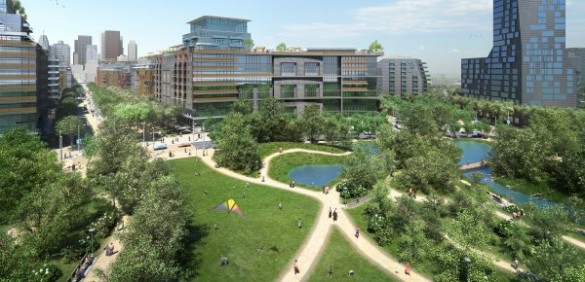The zombie dividend: Has apocalypse helped architecture?

After the storms and the shootings, we're ready for architecture that confers a sense of calm and protection. Two sides of the same coin -- defensive architecture, on the one hand, and restorative architecture on the other -- are equally in demand today. Will architects rise to the challenge?

The zombie meme that pervades American popular culture has certainly helped with the first criterion. We understand why we need fortresses, for enemies real or imagined. The latter notion -- buildings that heal -- represents an ancient art of making shelter that needs more attention. It's not the first thought that comes to mind when the imagined stalking hordes are breaching the moat.
Studies show that well-designed buildings can relieve anxiety, lower our blood pressure and sharpen thinking. Children in poorly designed buildings tend to display more distracted, hyperactive and tense behaviors.
Daylight, fresh air, and views of the outdoors are old ideas with fresh new data proving their ameliorative effects. More recent ideas for improving our mental states range from biophilia, championed by sustainable design experts like Stephen R. Kellert, as well as incorporating figurative art into buildings, according to such practitioners as Connecticut-based architect Barry Svigals.
1. Creating buildings that heal
New building design concepts can even heal themselves, in an almost literal sense. Some can recuperate sooner from disasters, as Andy Darrell write recently in Cogenerationmagazine, listing their use of batteries, solar power and combined heat & power to overcome power outages.
“Amid the darkness and devastation, there were dozens of homes, businesses, even whole communities that kept their lights on and the water because they were designed to isolate breakdowns, heal quicker, and work with natural systems rather than against them," Darrell reported.
New city plans will do the same. Lisa Rochon writes eloquently in The Globe & Mail about her city's Don River Park, which is essentially a combination of land art and flood protection. Designed by Michael van Valkenburgh Associates, the sculptural green space has an outdoor fireplace and recreation -- but its prescient flood plain will protect against threats like Hurricane Hazel, the 1954 trauma to the city.
2. Checking the downside of security
On the downside, our fascination with zombies is just another way to propagate ideas of us versus them -- the dangerous, unknown and senseless other. Yet by testing design ideas against the zombie rubric, architects can theorize about built solutions that address real threats.
Safer rooms are just a start. A recent project, “The Safe House” near Warsaw designed by architects KWK Promes, took the idea to the limit. Its thick walls, roll-down metal shutters and steel grey reinforced walls are clean, modern and repugnant to many.
Enthusiasts took issue with the ostentatious nature of The Safe House. In Guns & Ammo magazine, Patrick Sweeney cautioned that “excessively aggressive security measures" may help repel zombies but they could attract others. "Look too prosperous, and some will ask to join you, and perhaps not entirely politely,” he wrote. Conceal your weapon, presumably, is the takeaway?
3. Designing against aggression.
Yet there is proof that architecture can incite or mollify -- for the better. Swedish academic Roger S. Ulrich finally gave evidence-based design its bully pulpit in The New York Times this week. He aired out recent studies that prove the clinical benefits of good architecture for reducing violence.
Nature, gardens and art, as Ulrich has shown in his past work, can help hospital patients feel less pain and stress. It even cuts the cost of healthcare. The news, however, is that building design can reduce acts of aggression in psychiatric facilities. The hospitals with "stress-reducing features" required fewer patient sedations and less use of restraints.
These are ideas that can -- and should -- influence our designs not just for caregiving environments but also for building facades, high schools, parks, sidewalks and whole cities.
4. Boosting our own resilience.
We also need better building products to resist zombie attacks. A number of recent introductions have focused attention on how simple upgrades to architectural materials and systems can help reduce losses from natural disasters and violent attack.
A large number of products now on display at the vast expo halls of Bau 2013 in Munich, Germany, are focused on resisting environmental and security risks. Schott's Pyranova secure glass, for example, combines fire protection properties as well as anti-ballistic and strength properties -- "extremely high security requirements that apply to personal and property protection," says the company.
Like the glass, new defense systems tend to be well hidden from sight. The company Eco Building Products, for example, has introduced new assemblies that better resist fire, mold, wood-rot, termites and high winds, "providing protection up to nine feet above grade." This includes lumber and coatings with special properties that address the limitations of traditional felt paper and fabric and flimsy vapor barriers – a solution to “rising tides and high winds, let alone fire storms” says the company.
5. Becoming more self-sufficient
Resiliency is the new sustainability, as I wrote the other day in SmartPlanet's The Take.
When the zombies come knocking, we must have not only power and protection but also plenty of supplies to keep us nourished through the attack. Rainwater capture and storage can ensure there is fresh water; simple new systems include the new design by Chad Person for “networked rain barrels” that connect to a home’s gutters. Air Drop, a new invention by Edward Linacre, uses solar-powered condensation to harvest water from ambient air.
But water and food are only part of the sustenance we need. Today's zombie-proof architecture must help us keep our sanity, too.
A new architectural mindset is emerging that considers our emotional needs in the face of "everyday traumas," as the architect Svigals says, as well as the singular traumatic event. Today's leading architects will help bring new solutions that not only defend us, but that restore us as well.
Designing for the apocalypse has been a helpful experiment. Now it's time to use just as much creativity to address the shared challenges of our daily life.
This post was originally published on Smartplanet.com